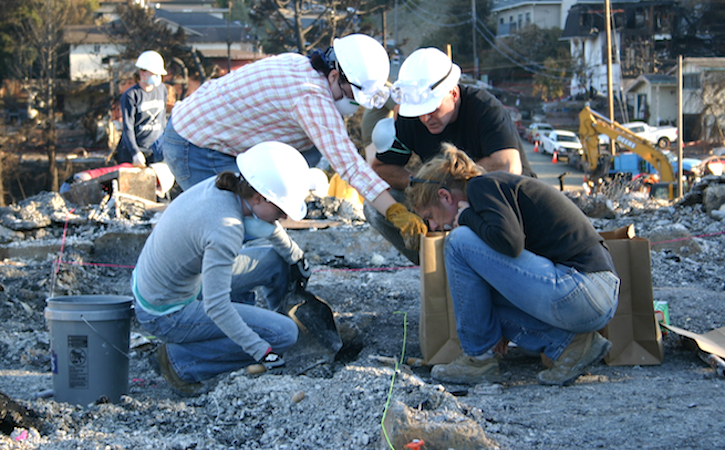
The Field of Bioarchaeology
Bioarchaeology is the contextualized analysis of human remains from historical and prehistorical archaeological sites as a means to understand the lived experiences of the communities represented in the burial samples. The field incorporates data, theories and methods from archaeology, geology, archival research, human and developmental biology, evolutionary biology, medicine, genetics, and epidemiology. Conceptually the modern approach to bioarchaeology interprets the data in a cultural-historical context within the framework of social theory drawing upon a wide range of academic fields such as cultural anthropology, political economics, ethnic studies, disability studies, and women and gender studies. Thus the scope of the field transcends the mere study “of bodies” to engage with larger sociocultural phenomena in past societies.
Research Directions at SF State
The M.A. Program in Bioarchaeology at S.F. State is distinguished by its research strengths in dental anthropology; the effects of biomechanical/occupational stress on the skeleton; and paleopathology (both dental and skeletal). Dr. Griffin’s research has examined the interaction of cultural practices and the oral microbiome in populations from ancient California and the contact period of the Southeast U.S. Ongoing collaborative research projects with students include the examination of dental decay and periodontal disease in ancient Native American populations of the Bay Area. Dr. Wilczak has done extensive research aimed at unraveling the complexity of biological and mechanical factors contributing to changes at the skeletal attachments of muscles and ligaments (entheses) and has conducted studies of bone-forming diseases (e.g., DISH, HFI). On-going research projects with graduate students include studies of orbital lesions and non-lethal cranial trauma.
M.A. Student Opportunities
The bioarchaeology program at San Francisco State welcomes MA students with research interests in all aspects of human skeletal biology but with particular emphases on dental anthropology, paleopathology and the effects of stress on the skeleton. In addition to required seminar coursework in archaeology, cultural, visual, and biological anthropology, students can tailor electives in paleopathology, bioarchaeology, human osteology, fossil humans, archeological theory and methods, zooarchaeology and historical archaeology to complement their background and research interests. The NAGPRA program at SF State has also provided practical training for our MA students. Students interested in forensic applications receive training in the basic research methods of forensic anthropology and internships with city and county agencies can provide applied experiences. The department has two competitive student scholarships to help you finance additional field experiences or MA research projects. Watch a video interview with one of our former students to learn more about the opportunities available and how to leverage your MA program to reach your career goals.
Our program is appropriate for students wishing to pursue doctoral studies or those seeking an MA as terminal degree in preparation for careers in museum collection management and education, cultural resource management, NAGPRA lab assistants, forensic anthropology technician, archaeological survey and science journalism. Recent bioarchaeology graduate students have entered Ph.D. programs at UC Berkeley or found employment with the California Academy of Science; the San Mateo County Coroner’s office; lecturer and coordinator of the Human Anatomy Lab at San Francisco State University; California Department of Water Resources (Environmental Planner).
Dr. Mark Griffin mentors student research projects in dental pathology and contextualized bioarchaeological studies of precontact Californians although student’s with other geographic regional interests can be supported. He also welcomes students with interests in forensic taphonomy and in validation studies of human osteological markers of individuation that are relevant in a forensic context. Learn more about Dr. Griffin’s research projects on his faculty webpage.
Dr. Cynthia Wilczak mentors student research projects studying the effects of mechanical stress on the skeleton (entheseal changes or non-metric stress lesions); paleopathology (both skeletal and archival research) and general skeletal biology. She would support new cross-disciplinary projects with medical anthropology students conducting ethnographies with individuals living with diseases that impact the skeleton. She also welcomes students with computer programming skills who are interested in developing data collection and database management applications. Learn more about Dr. Wilczak’s work on her faculty webpage.
Recent M.A. Theses in Bioarchaeology
2018 Sophie Minnig, “Entheseal Changes in an Ancient Egyptian Skeletal Collection”
2018 Hannah Miller, “Pathological Cranial Lesions in a Juvenile Cranial Collection”
2018 Devan Glensor, Assessing Post Mortem Interval of Sus domesticus in a Northern California Environment.”
2017 Cheryl Tripathi, “Dem Bones: Curating the Anatomical Collection at San Francisco State University.”
2017 A. Devon Botham, “Are Nonlethal Cranial Injuries Being Over-diagnosed in the Archaeological Record? An Interdisciplinary Literature Review of Diagnostic Criteria for Healing, Depressed Cranial Fractures”
2016 Melissa Rodrigues, “Dental Caries Prevalence in a Late 19th to Early 20th Century Cemetery in San Jose, California.”
2014 Jessica Edwards, “Morphological Variability in prehistoric Central California, CA-CCO-548”
2013 Christina Alonso, “Orbital lesions in highland and lowland Peru”
2012 Monica Nolte, “ Musculoskeletal Attachments, Body Size and the Biceps Tuberosity in Three Dimensions.”
2012 Andrea Guidara, “Discriminant Function Analysis for Sex Determination using Tooth Size at the Vineyards site (4CCO548)”
2012 Heather Bradford, “One of Us: Analyzing Social Integration in a Protohistoric Pueblo Site through Dental Caries.”
2012 Guadalupe Ochoa, “Cribra Orbitalia and Porotic Hyperostosis in Middle Horizon Peru: An osteological Analysis of Collato and Tenahaha.”
2012 Tesla Monson, “Metameric Variation in the Expression of the Interconulus in Papio and Macaca.”
2011 Jennifer Blake, “Nonalimentary Tooth Use in Ancient California.”
2010 Gloria Nusse, “Artistic and Observer Bias in Forensic Facial Reconstruction”
2010 Phillip Grant Reid, “Osteological Evidence of Trauma and Interpersonal Violence at CA-ALA-343 in Fremont, California”